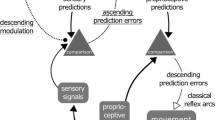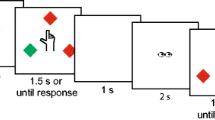Abstract
Simulation mechanisms are thought to play an important role in action recognition. On this view, actions are represented through the re-enactment of the observed action. Mirror neurons are thought to be the neuronal counterpart of such a process, and code actions at a rather abstract level, often generalizing across sensory modalities and effectors. In humans, attention has been focussed on the somatotopic, effector dependent representation of observed actions in the mirror system. In this series of behavioural studies, we used incidental repetition priming to determine to which degree the cognitive representation of observed actions relies on effector- and target-dependent representations. Participants were presented with images depicting meaningless or meaningful actions and pressed a button only when presented with a meaningful action. Images were classified as depicting a repeated or new action, relative to the previous image in the trial series. In the first experiment, we demonstrate a priming effect based on the repetition of an action, performed by the same effector over the same target object. In the second experiment, we demonstrate that this facilitation holds even when the same action is performed over a different target object. Finally, in the third experiment we show that the action priming effect holds even when the same action is accomplished with different effectors. These results suggest the existence of a cognitive representation of actions, automatically activated during observation, which is abstract enough to generalize across different targets for that action and different effectors performing that action.



Similar content being viewed by others
References
Aziz-Zadeh L, Wilson SM, Rizzolatti G, Iacoboni M (2006) Congruent embodied representations for visually presented actions and linguistic phrases describing actions. Curr Biol 16:1818–1823
Barsalou LW (1999) Perceptual symbol systems. Behav Brain Sci 22:577–609
Binkofski F, Amunts K, Stephan K, Posse S, Schormann T, Freund H, Zilles K, Seitz R (2000) Broca’s region subserves imagery of motion: a combined cytoarchitectonic and fMRI study. Hum Brain Mapp 11:273–285
Bekkering H, Wohlschlager A, Gattis M (2000) Imitation of gestures in children is goal-directed. Q J Exp Psychol A 53:153–164
Borghi AM (2004) Object concepts and action: extracting affordances from objects parts. Acta Psychol 115:69–96
Brass M, Bekkering H, Prinz W (2001) Movement observation affects movement execution in a simple response task. Acta Psychol 106:3–22
Buccino G, Binkofski F, Fink GR, Fadiga L, Fogassi L, Gallese V, Seitz RJ, Zilles K, Rizzolatti G, Freund HJ (2001) Action observation activates premotor and parietal areas in a somatotopic manner: an fMRI study. Eur J Neurosci 13:400–404
Buccino G, Riggio L, Melli G, Binkofski F, Gallese V, Rizzolatti G (2005) Listening to action-related sentences modulates the activity of the motor system: a combined TMS and behavioral study. Cogn Brain Res 24:355–363
Buckner R, Koutstaal W (1998) Functional neuroimaging studies of encoding, priming, and explicit memory retrieval. Proc Natl Acad Sci USA 95:891–898
Burstedt MKO, Benoni BE, Roland SJ (1997) Coordination of fingertip forces during human manipulation can emerge from independent neural networks controlling each engaged digit. Exp Brain Res 117:67–79
Calinon S, Guenter F, Billard A (2005) Goal-directed imitation in a humanoid robot. In: IEEE international conference on robotics and automation, Barcelona, Spain
Catmur C, Walsh V, Heyes C (2007) Sensorimotor learning configures the human mirror system. Curr Biol 17:1527–1531
Coles M, Gratton G, Bashore T, Eriksen C, Donchin E (1985) A psychophysiological investigation of the continuous flow model of human information processing. J Exp Psychol Hum Percept Perform 11:529–553
Costantini M, Galati G, Ferretti A, Caulo M, Tartaro A, Romani GL, Aglioti SM (2005) Neural systems underlying observation of humanly impossible movements: an fMRI study. Cereb Cortex 15:1761–1767
Craighero L, Bello A, Fadiga L, Rizzolatti G (2002) Hand action preparation influences the responses to hand pictures. Neuropsychologia 40:492–502
Cross ES, AFdC Hamilton, Grafton ST (2006) Building a motor simulation de novo: observation of dance by dancers. Neuroimage 31:1257–1267
Dehaene S, Naccache L, Clec’H GL, Koechlin E, Mueller M, Dehaene-Lambertz G, van de Moortele PF, Le Bihan D (1998) Imaging unconscious semantic priming. Nature 395:597–600
De Jong R, Liang C, Lauber E (1994) Conditional and unconditional automaticity: a dual-process model of effects of spatial stimulus–response correspondence. J Exp Psychol Human Percept Perform 20:731–750
Di Pellegrino G, Fadiga L, Fogassi L, Gallese V, Rizzolatti G (1992) Understanding motor events: a neurophysiological study. Exp Brain Res 91:176–180
Di Pellegrino G, Rafal R, Tipper SP (2005) Implicitly evoked actions modulate visual selection: evidence from parietal extinction. Curr Biol 15:1469–1472
Fadiga L, Fogassi L, Pavesi G, Rizzolatti G (1995) Motor facilitation during action observation: a magnetic stimulation study. J Neurophysiol 73:2608–2611
Fogassi L, Gallese V, Fadiga L, Rizzolatti G (1998) Neurons responding to the sight of goal-directed hand/arm actions in the parietal area PF (7b) of the macaque monkey. Soc. Neurosci. Abs. 275.5
Fogassi L, Ferrari PF, Gesierich B, Rozzi S, Chersi F, Rizzolatti G (2005) Parietal lobe: from action organization to intention understanding. Science 308:662–667
Galati G, Committeri G, Aprile T, Spitoni G, Di Russo F, Pitzalis S, Pizzamiglio L (2008) A selective representation of the meaning of actions in the auditory mirror system. Neuroimage 40:1274–1286. doi:doi: 10.1016/j.neuroimage.2007.12.044
Gallagher S (2007) Simulation trouble. Soc Neurosci 2:353–365
Gallese V, Lakoff G (2005) The brain’s concepts: the role of the sensory-motor system in reason and language. Cogn Neuropsychol 22:455–479
Gallese V, Fadiga L, Fogassi L, Rizzolatti G (1996) Action recognition in the premotor cortex. Brain 119:593–609
Gazzola V, Aziz-Zadeh L, Keysers C (2006) Empathy and the somatotopic auditory mirror system in humans. Curr Biol 16:1824–1829
Gazzola V, van der Worp H, Mulder T, Wicker B, Rizzolatti G, Keysers C (2007) Aplasics born without hands mirror the goal of hand actions with their feet. Curr Biol 17:1235–1240
Gibson JJ (1979) The ecological approach to visual perception. Houghton-Mifflin, Boston
Grafton ST, Fadiga L, Arbib MA, Rizzolatti G (1997) Premotor cortex activation during observation and naming of familiar tools. Neuroimage 6:231–236
Grezes J, Decety J (2002) Does visual perception of object afford action? Evidence from a neuroimaging study. Neuropsychologia 40:212–222
Grezes J, Armony JL, Rowe J, Passingham RE (2003) Activations related to “mirror” and “canonical” neurones in the human brain: an fMRI study. Neuroimage 18:928–937
Hamilton AF, Grafton ST (2006) Goal representation in human anterior intraparietal sulcus. J Neurosci 26:1133–1137
Hamilton AF, Grafton ST (2007) The motor hierarchy: from kinematics to goals and intentions. In: Haggard P, Rossetti Y, Kawato M (eds) Sensorimotor foundations of higher cognition. Attention and performance XXII. Oxford University Press, Oxford
Hanson C, Hirst W (1989) On the representation of events: a study of orientation, recall, and recognition. J Exp Psychol Gen 118:136–147
Hauk O, Johnsrude I, Pulvermüller F (2004) Somatotopic representation of action words in human motor and premotor cortex. Neuron 41:301–307
Henson RNA, Rugg MD (2003) Neural response suppression, haemodynamic repetition effects, and behavioural priming. Neuropsychologia 41:263–270
Hughes O, Abbs JH (1976) Labial–mandibular coordination in the production of speech: Implications for the operation of motor equivalence. Phonetica 44:199–221
Iacoboni M, Woods RP, Brass M, Bekkering H, Mazziotta JC, Rizzolatti G (1999) Cortical mechanisms of human imitation. Science 286:2526–2528
Iacoboni M, Molnar-Szakacs I, Gallese V, Buccino G, Mazziotta J, Rizzolatti G (2005) Grasping the intentions of others with one’s own mirror neuron system. PLoS Biol 3:e79
Kable JW, Chatterjee A (2006) Specificity of action representations in the lateral occipitotemporal cortex. J Cogn Neurosci 18:1498–1517
Kable JW, Lease-Spellmeyer J, Chatterjee A (2002) Neural substrates of action event knowledge. J Cogn Neurosci 14:795–805
Kable JW, Kan IP, Wilson A, Thompson-Schill SL, Chatterjee A (2005) Conceptual representations of action in the lateral temporal cortex. J Cogn Neurosci 17:1855–1870
Keele SW, Cohen A, Ivry R (1990) Motor programs: concepts and issues. In: Jeannerod M (ed) Attention and performance, XIII: motor representation and control. Erlbaum, Hillsdale, NJ, pp 77–107
Kohler E, Keysers C, Umiltà MA, Fogassi L, Gallese V, Rizzolatti G (2002) Hearing sounds, understanding actions: action representation in mirror neurons. Science 297:846–848
Koski L, Wohlschlager A, Bekkering H, Woods RP, Dubeau M-C, Mazziotta JC, Iacoboni M (2002) Modulation of motor and premotor activity during imitation of target-directed actions. Cereb Cortex 12:847–855
Kourtzi Z, Kanwisher N (2000) Cortical regions involved in perceiving object shape. J Neurosci 20:3310–3318
Lahav A, Saltzman E, Schlaug G (2007) Action representation of sound: audiomotor recognition network while listening to newly acquired actions. J Neurosci 27:308–314
Lashley K (1951) The problem of serial order in behavior. Wiley, New York
Majdandzic J, Grol MJ, van Schie HT, Verhagen L, Toni I, Bekkering H (2007) The role of immediate and final goals in action planning: an fMRI study. Neuroimage 37:589
Miller GA, Galanter E, Pribram K (1960) Plans and the structure of behavior. Rinehart and Winston, New York
Murata A, Fadiga L, Fogassi L, Gallese V, Raos V, Rizzolatti G (1997) Object representation in the ventral premotor cortex (area F5) of the monkey. J Neurophysiol 78:2226–2230
Newman-Norlund RD, van Schie HT, van Zuijlen AMJ, Bekkering H (2007) The mirror neuron system is more active during complementary compared with imitative action. Nat Neurosci 10:817–818
Newtson D (1973) Attribution and the unit of perception of ongoing behavior. J Pers Soc Psychol 28:28–38
Phillips JC, Ward R (2002) S-R correspondence effects of irrelevant visual affordance: time course and specificity of response activation. Vis Cogn 9:540–548
Pizzamiglio L, Aprile T, Spitoni G, Pitzalis S, Bates E, D’Amico S, Di Russo F (2005) Separate neural systems for processing action- or non-action-related sounds. Neuroimage 24:852–861
Pobric G, de C Hamilton AF (2006) Action understanding requires the left inferior frontal cortex. Curr Biol 16:524–529
Schacter DL, Buckner RL (1998) Priming and the brain. Neuron 20:185–195
Tettamanti M, Buccino G, Saccuman MC, Gallese V, Danna M, Scifo P, Fazio F, Rizzolatti G, Cappa SF, Perani D (2005) Listening to action-related sentences activates fronto-parietal motor circuits. J Cogn Neurosci 17:273–281
Tucker M, Ellis R (1998) On the relations between seen objects and components of potential actions. J Exp Psychol Hum Percept Perform 24:830–846
Tversky B, Hemenway K (1984) Objects, parts, and categories. J Exp Psychol Gen 113:169–193
Umiltà MA, Kohler E, Gallese V, Fogassi L, Fadiga L, Keysers C, Rizzolatti G (2001) I know what you are doing: a neurophysiological study. Neuron 31:155–165
Umiltà MA, Escola L, Intskirveli I, Grammont F, Rochat M, Caruana F, Jezzini A, Gallese V, Rizzolatti G (2008) When pliers become fingers in the monkey motor system. Proc Natl Acad Sci USA 105:2209–2213. doi:10.1073/pnas.0705985105
Urgesi C, Candidi M, Ionta S, Aglioti SM (2007) Representation of body identity and body actions in extrastriate body area and ventral premotor cortex. Nat Neurosci 10:30–31
Vallacher RR, Wegner DM (1987) What do people think they’re doing? Action identification and human behavior. Psychol Rev 94:3–15
Acknowledgments
We are grateful to Francesca Defeudis and Antonello Baldassarre for their help in collecting and analyzing data, and to Bernhard Hommel for his comments on a previous version of this manuscript.
Author information
Authors and Affiliations
Corresponding author
Electronic supplementary material
This material is unfortunately not in the Publisher's archive anymore:
Meaningful actions used in experiments 1 and 3. (TIFF 1341 kb)
Meaningless actions used in all the experiments. (TIFF 603 kb)
Meaningful actions used in experiment 2. (TIFF 1347 kb)
Rights and permissions
About this article
Cite this article
Costantini, M., Committeri, G. & Galati, G. Effector- and target-independent representation of observed actions: evidence from incidental repetition priming. Exp Brain Res 188, 341–351 (2008). https://doi.org/10.1007/s00221-008-1369-x
Received:
Accepted:
Published:
Issue Date:
DOI: https://doi.org/10.1007/s00221-008-1369-x




